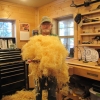Some of you will have my book, Elements of Woodcarving (GMC Publications Ltd, UK. 2000). In there you'll find me carving butterflies. That chapter is a re-working of the very first article I wrote for Woodcarving Magazine, the first issue, which in turn was the very first thing I ever wrote about woodcarving.
So I'm very fond of these little creatures and, with the blessing of my publishers, I'm really pleased to show you, in real time, how I carve a moth. Delicate work needing a steady hand, but challenging fun. You can add them to carved flowers, cupboard doors - even your hat!
This lesson introduces the project, looks at wood and drawing out the moth.
Wood: I was given some beautiful yellow 'Californian Nutmeg' and I thought I'd give it a go. In the end this was not a good choice: a bit too straight and weak grained for carving. I made it, as you see, but it was a struggle. I'd suggest you find another wood: Birds Eye Maple, Yew; something with a good figure or pattern, and a tighter bind to the fibres.
You can research and design your own moth or butterfly of course, or choose to use my working drawing and tool list below, for subscribing members only.

| 22 April 2019 21:49
Jof - Yes, just straight PVA wood glue.

| 22 April 2019 16:18
Hi Chris. What did you use to join the two pieces of wood together? Is simple PVA sufficient?

| 18 August 2013 16:37
Eric - I think the videos in Techniques > Holding Work cover pretty much everything I do. I try and cover what you need for individual projects. All my other work - not on the site - are just more of the same. Keep it simple!

| 17 August 2013 17:09
Chris, just a reminder that you have lots of ways of holding work that you do naturally, automatically, thinking almost nothing of it. But for us newbies, these are invaluable, even a simple on like you just used in this project. So you might want to collect all of your "no-brainer" ways of holding work in one place so we can figure out what to do with each project.

| 21 March 2013 08:42
Steven - You could use it, sure. Carbon paper ink never seems to dry properly on the wood - or I never leave it long enough - so the surface tends to end up smeared. It's best used when the drawing on the wood is cut away completely and quickly. CP is less available now so I've been trying to suggest alternatives, as here. Or, as elsewhere on the site, gluing on the printed drawing, or simply pressing a point against the line to dent the wood

| 20 March 2013 14:20
Do you not like carbon paper? Nice designs by the way....